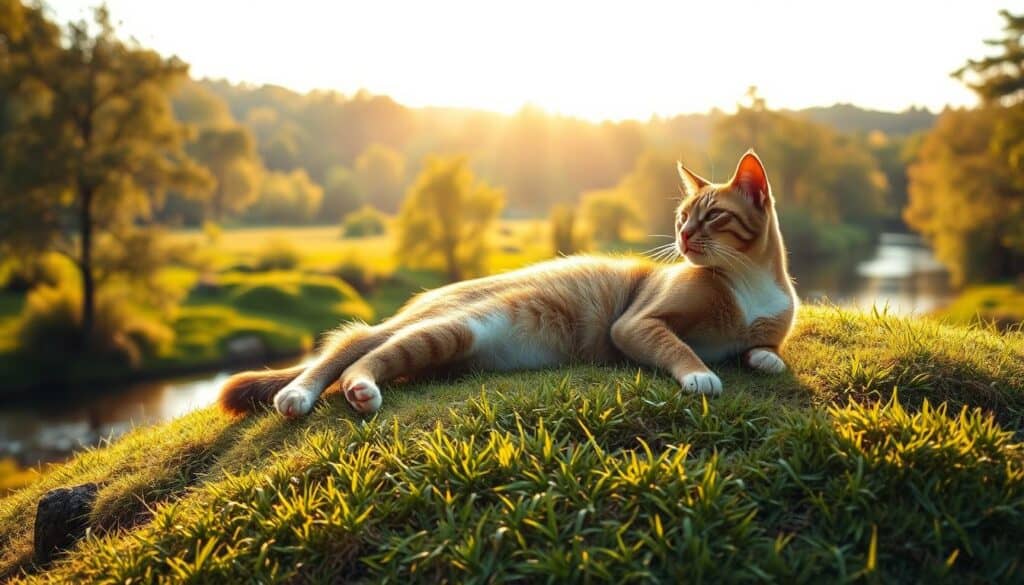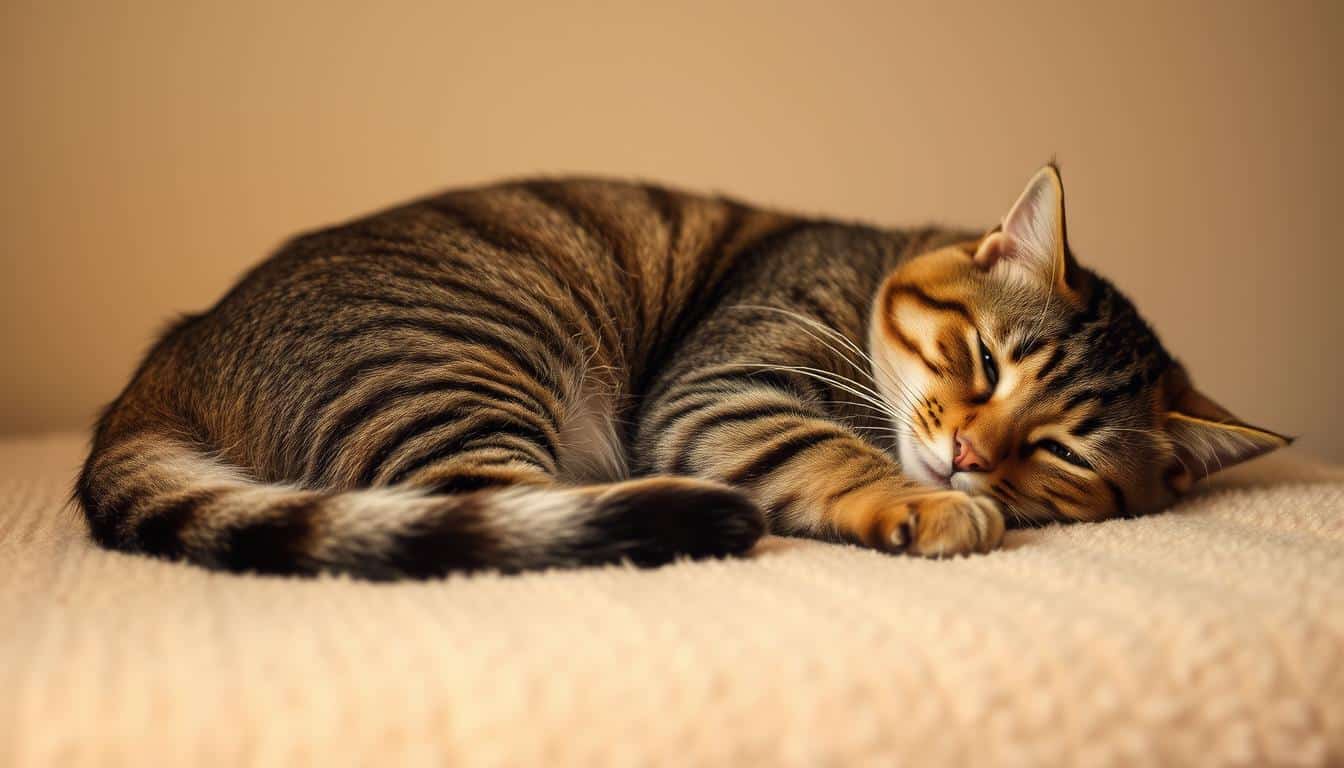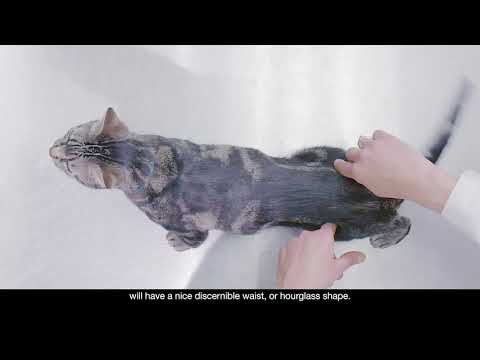Keeping your cat at a healthy weight is one of the best steps you can take to protect its long-term wellbeing. This short guide gives clear, vet-approved steps to understand and manage body condition over time.
More than half of cats in the U.S. are now overweight or obese, and the AVMA lists obesity as a disease. Carrying extra pounds raises risk for diabetes, urinary problems, arthritis, and shortens life.
Rather than focus only on a number, learn to read a 9-point Body Condition Score. Vets look for ribs you can feel, a slight waist from above, and minimal abdominal fat. Many adults fall near an ideal weight of 8–12 pounds, but frame and muscle matter most.
This guide will help you spot early changes, support safe loss or gain, and build simple routines—scheduled meals, play, and smarter treats—that fit busy homes. Small, steady steps add up, and sudden shifts in mass deserve prompt veterinary attention.
Key Takeaways
- Obesity is a disease: over half of domestic cats are affected.
- Use the 9-point body condition scale to judge shape, not just the scale.
- Ideal weight often falls near 8–12 lb, but frame and muscle matter more.
- Simple routines—meals, play, and treat control—help steady progress.
- Watch for sudden changes; see a vet if your pet loses or gains quickly.
- Small, consistent changes over time lead to lasting results.
Why Cat Weight Matters for Health and Longevity
Keeping a healthy mass matters well beyond looks — it shapes how long and well a pet lives. Extra pounds are common and have real consequences for daily comfort and lifespan.
Obesity recognized and how common it is
The AVMA classified obesity as a disease in 2018. Today about 59.5–61% of household cats are overweight or obese.
Risks of carrying extra pounds versus losing them unexpectedly
Carrying extra pounds raises the chance of diabetes, arthritis, pancreatitis, urinary problems, liver disease (including hepatic lipidosis), kidney disease, and skin and joint issues.
Unplanned weight loss or losing weight fast can signal hyperthyroidism, kidney or liver disease, IBD, dental or respiratory problems, pain, or pancreatitis. If a cat stops eating, hepatic lipidosis can develop quickly and needs immediate vet care.
- Note: Even two extra pounds on a small body can strain joints and worsen mobility.
- Track appetite, water intake, litter box habits, and energy—subtle shifts often appear first.
- Routine check-ins with your vet help interpret trends and pick the right food and plan.
| Issue | Typical sign | Why it matters | When to call a vet |
|---|---|---|---|
| Extra pounds | Reduced activity, harder grooming | Raises chronic disease risk; shortens life | If gain is steady over months |
| Unplanned loss | Smaller body, less appetite | May indicate serious illness | Rapid loss or appetite stop |
| Sudden anorexia | Refuses food for 48+ hours | Risk of hepatic lipidosis in heavier cats | Immediate veterinary care |
Addressing mass is not about blame. Simple daily habits — scheduled meals, regular play, and measured portions — protect mobility and add years of comfortable life. The next sections show how to assess condition and choose safe, effective steps.
Understanding Ideal Cat Weight: A Beginner’s Look at Body Condition, Breed, and Age
Understanding a healthy form starts with seeing shape, not just a number on the scale. Many adult pets fall near an 8–12 pounds range, but frame and lean muscle set each animal’s true ideal weight.
The 8–12 lb guideline and why frame and muscle mass matter
The 8–12 pound range is a helpful starting point for many. It is not a rule. Two animals at the same pounds can look and move very differently.
Frame and muscle determine comfort and mobility. Aim for a fit, toned body rather than chasing a single number.
Using the 9-point Body Condition Score: ribs, waist, and abdominal fat pad
The 9-point body condition chart ranks 1 (emaciated) to 9 (morbidly obese). A score of 4–5 is ideal.
Feel along the ribs for a thin fat cover. From above you should see a slight waist. From the side, only a minimal abdominal pad should show.
Breed differences, age, and spay/neuter effects on metabolism
Breed matters. Smaller breeds like Abyssinian or Siamese often fall under 8 pounds and remain healthy. Large breeds such as a Maine Coon can be 20+ pounds and still be ideal.
Age and spay/neuter status change appetite and metabolism. Kittens grow fast; adults stabilize; seniors may lose pounds from disease. After spay/neuter, adjust food and activity to match lower energy needs.
- Ask your vet to assign a body condition score and review a chart during checkups.
- Take monthly photos (above and side) to track shape over time.
- Prioritize lean muscle and mobility when setting goals for a healthy weight cat.
How to Assess Cat Health Weight at Home
You can catch subtle changes in form with simple steps you do at home. Regular checks help spot slow trends before they become problems.
Easy home scale method: Step on a bathroom scale, note the number. Then pick up your pet and step on again. Subtract your first reading from the second to get an accurate cat weight.
Hands-on body check
Gently run your fingers along the ribs. You should feel ribs under a thin fat cover.
From above, look for a slight hourglass or waist. From the side, only a small abdominal tuck should show.
- Log the number at the same time each month to avoid daily fluctuation.
- Compare your findings to a 9-point chart to match what vets use.
- Avoid free-feeding bowls; set meal times to track intake and spot changes in feeding.
- Long or fluffy fur can hide contours—trust your hands more than your eyes.
- Take top and side photos monthly in the same spot and light for clear comparison.
| Check | What to look for | When to call a vet |
|---|---|---|
| Scale | Consistent monthly shifts in numbers | If loss or gain is steady over weeks |
| Rib feel | Ribs felt under slight fat cover | If ribs are hard to feel or too prominent |
| Shape photos | Subtle hourglass from above; small tummy tuck | Noticeable change in shape or mobility |
Pair weigh-ins with brief notes on appetite, activity, and litter box habits. Be calm and gentle so checks feel like positive attention.
If anything worries you, contact your veterinarian rather than waiting. Early adjustments are easier and safer than late fixes.
Healthy Weight Loss for Overweight or Obese Cats
Begin any slimming plan with a veterinary exam to rule out medical causes and set safe goals. A vet will recommend a weekly loss rate and timeline tailored to your pet.

Work with your veterinarian: safe targets and timeline
Safe loss is gradual. Losing one pound often takes 6–12 months. Rapid cuts risk serious liver problems.
Feeding strategy and diet choices
Swap free-feeding for measured meals. Use a kitchen scale or scoop to control the amount of food and calories.
Try canned, protein-forward options or prescription diets your vet approves. These usually offer more protein and fewer carbs per calorie.
Treats and smart calorie management
- Limit treats to a small slice of daily calories.
- Use low-calorie snacks or non-food rewards like play or grooming.
Activity, play, and enrichment
Short play sessions (about 20 minutes, several times a day) work best. Rotate wand toys, lasers, and climbing shelves to keep exercise fun.
Food puzzles and timed feeders slow eating and add mental work.
Multi-cat feeding tips
Feed in separate rooms or use microchip bowls so each animal only accesses its bowl. This prevents accidental overeating and keeps the plan fair.
Track progress with regular weigh-ins and body checks. If appetite falls or the pet stops eating, contact your vet immediately.
Helping an Underweight Cat Gain Weight Safely
When a pet loses mass without a clear reason, prompt veterinary review protects recovery and guides feeding.
Rule out disease first. Rapid or unexplained loss may reflect hyperthyroidism, kidney or liver disease, IBD, dental or respiratory trouble, pain, or pancreatitis. A vet or veterinarian exam is essential before changing diet.
Calorie-dense, protein-forward options
Choose calorie-dense canned food that is high in protein to support lean mass and steady weight gain. Warming wet food by a few seconds raises aroma and often boosts appetite.
Small, frequent meals and stress-free feeding
Offer small meals several times a day. Hand-feeding or sitting nearby can encourage hesitant eaters. Keep food, water, and the bowl away from litter and noisy areas to reduce stress.
- Track daily food amount and weekly body mass to measure progress.
- Try different textures (pâté, shreds) and limited treats as incentives.
- Add gentle play sessions to stimulate appetite and preserve muscle.
| Goal | Action | When to call the vet |
|---|---|---|
| Confirm cause | Schedule veterinary exam and tests | Rapid loss or appetite drop |
| Increase intake | High-calorie wet food; warm and offer small meals | Refusal to eat 24–48 hours |
| Monitor progress | Daily intake log; weekly weigh-ins at home | No gain after 2–4 weeks |
If your pet refuses food, call your vet right away. Cats can develop serious liver disease if they stop eating.
Conclusion
Aim for a fit, comfortable body shape rather than a single number on the scale. Use the 9-point chart and simple home weigh-ins to guide day-to-day choices and track progress.
Obesity is common but preventable. Gentle, consistent routines—measured meals, protein-forward canned food, smart treats, food puzzles, and short play or exercise sessions—deliver steady results over months, not days.
Adjust goals by breed and age; a Maine Coon may carry more pounds and still be ideal. Keep a brief log of food amounts, weekly weights, and activity, and check with your vet to refine plans as your pet ages.
Small changes today can add comfort and extra years to your pet’s life. Celebrate steady gains and share progress with your veterinary team.




